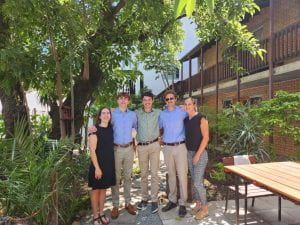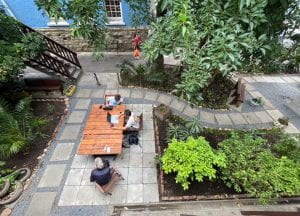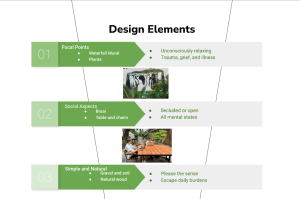Gardens for the Wellness of the Body and Mind
Project Sponsor: The Hope Exchange
Sponsor Liaison: Charity Poté (Social Work Manager)
Student Team Members: Tristan Andrew (Mechanical Engineering ’24), Keelan Boyle (Robotics & Environmental Sustainability ’24), Sarah LaRusso (Mathematics & Computer Science ’24), Daniel Ouellette (Mechanical Engineering ’24), Jena Taubert (Mechanical Engineering ’24)
WPI Advisors: Professor Gbetonmasse Somasse & Professor Thidinalei Tshiguvho
Link to Garden Maintenance Books
Abstract
The Hope Exchange, a nonprofit organization in Cape Town, provides temporary housing to men who are at risk of homelessness at the Geoff Burton House with the goal of reintegration back into society. To support this cause, our team designed and implemented sustainable and effective garden spaces to promote healing, hope, and nourishment. We conducted resident and expert interviews at local gardens to determine the most efficient ways to develop these gardens. We designed and implemented the gardens based on the needs of the residents and incorporated elements that promote healing. We further developed recommendations for the maintenance and sustainability of the gardens. We believe that with continued maintenance and improvements, the gardens will achieve our goal of providing healing, hope, and nourishment.

The five students from Worcester Polytechnic Institute working with The Hope Exchange on a healing garden and vegetable garden. Pictured From left to right, Sarah LaRusso, Tristan Andrew, Keelan Boyle, Daniel Ouellette, and Jena Taubert.
Cape Town Bench Review:
Bench Review
Executive Summary
The Hope Exchange, Helping the Homeless:
The apartheid practice of forceful eviction and relocation of District Six’s original inhabitants to the city’s outskirts destabilized a prospering black and colored cultural hub (South African History Online, 2022). These evictions left many residents dispossessed and on the streets. Even after 30 years, Old District Six is still recovering from those evictions, with roughly 8,000 homeless people within its borders (The Hope Exchange, 2021). The Hope Exchange is a nonprofit organization that dedicated itself to “bring[ing] hope for the homeless, through dignity and opportunities for change” (The Hope Exchange, 2021). There are free ablutions, health clinics, and social services at The Hope Exchange to aid in this process. To further its mission, the organization formed the Geoff Burton House for men in the exit stages of homelessness. In support of the Geoff Burton residents during this transition period, our team collaborated with The Hope Exchange to design sustainable and effective garden spaces to promote healing, hope, and nourishment.
These garden spaces will consist of a healing garden in front of the residency and a vertical vegetable garden in the back. Healing gardens provide a space for residents to become one with their thoughts and feel physically and mentally distanced from demanding tasks (Stigsdotter & Grahn, n.d.). While the healing garden would be a space of serenity, the vegetable garden could bring forth healing through physical gardening and organic nourishment. Urban community gardens are an effective way for residents to farm fresh, organic fruits and vegetables. However, a city space can be a limiting factor for growing vegetables because of its natural space limitations. Because of this, vertical gardening strategies thrive in urban communities such as District 6 in Cape Town, South Africa. Our goal for the design of the two gardens was to provide the most health and social benefits for Geoff Burton House residents.
Our Approach
To achieve our goal of designing and implementing sustainable and effective garden spaces to promote healing, hope, and nourishment, we developed the following objectives:
- Assess the needs and preferences of the residents for the gardens.
- Identify materials, garden components, and other resources to support the healing and vegetable gardens.
- Design and implement an upgraded healing garden and a vertical structure for the vegetable garden, with a maintenance plan that best fits the needs of the Geoff Burton House.
We interviewed residents at the Geoff Burton House in small focus groups. In these interviews, we gained knowledge about the concerns and preferences of each garden. Our team also interviewed local experts at Kirstenbosch National Botanical Garden and Khulisa Community Garden to gain professional expertise and recommendations on healing and vegetable gardens. Additionally, we conducted a site assessment to see the previous garden spaces and identify recyclable resources.
We were able to design the healing and vegetable gardens based on recommendations from the interviews and professional advice. To finance most of the project, we set up a GoFundMe donation page and were fortunate enough to raise R20.506,97 (USD 1,195) for materials. We then were able to design our gardens on a budget and implement them based on the interview information. To ensure the maintenance and sustainability of our work, we developed a maintenance manual that describes the necessary information for repairs, cleaning, and plant preservation.
A Healing Garden for Wellbeing:

Figure E1. The images show the completed healing garden in front of the Geoff Burton House at The Hope Exchange.
From the small group interviews, we learned that residents wanted a braai stand, new tables and chairs, sturdy ground cover, and the garden to be transformed into a healing space (Figure E1). A major concern was that the garden was considered a smoking area, which gave us more incentive to transform that area into a healing garden and implement a designated smoking area in the final design. Through our expert interview at Kirstenbosch National Botanical Garden, we gained insight into ideas for the healing garden. Some of their recommendations included planting native plants, having a natural ground cover, and incorporating a water feature which we unfortunately determined would not be feasible. Instead, we incorporated a waterfall mural as natural art increases security and reduces anxiety.
The final design for the healing garden incorporated a mural as a focal point, a braai stand, soil and gravel, new plants, and fixed-up tables and chairs; each element contributed uniquely to the healing effect (Figure E2). The mural and plants encourage a sense of relaxation and reduced stress for the garden user. The soil and gravel combine to create a visually pleasing contrast of texture with similar effects. The incorporation of a braai stand, tables, and chairs promotes socialization by bringing together the members of the Geoff Burton House and creating a stronger community.

Figure E2. The diagram above demonstrates different design elements of a healing garden and describes how they help to create an effective healing space.
A Vegetable Garden for Nourishment:
The vegetable garden was also designed based on information and recommendations from the residents and local experts. From the interviews, we learned that the residents wanted the following vegetables in the garden: chilis, cabbage, kale, carrots, and potatoes. As for the physical design of the vertical aspect, there were no outstanding favorites between shelves, trellises, garden boxes, and hanging pots. This left the decision up to our team, and we ultimately decided to build shelves and garden boxes. The shelving was selected based on maximizing sunlight and space given in the area we had to work with. Some of the challenges residents raised during the interviews included a lack of motivation to maintain the gardens and the problem of pests and rats eating the produce. It was recommended by Khulisa Community Garden that we incorporate vertical gardening strategies, companion planting, and general rat and pest deterrent approaches. Making the garden vertical will help provide more room for additional vegetables and protect them, as it would be harder for rats and pests to get to plants.
The finalized design for the vegetable garden included shelving, garden boxes, and recycled pots (Figure E3). The shelving and boxes will help produce a higher quantity of fresh vegetables and encourage healthier lifestyle choices for the residents. The vegetable garden provides rehabilitation through collaboration, ownership, and maintenance. The daily maintenance and interactions will help create a safe space at the shelter and allow for unconscious healing and stability.

Figure E3. The images show the completed shelving and garden boxes in the vertical vegetable garden at The Hope Exchange.
Conclusion:
The process of implementing the gardens brought the community together and sparked interest in the gardens. These spaces will provide healing, nourishment, and work skills to the current and future residents at the Geoff Burton House which we hope will ultimately assist them with their transition period back into society.
Recommendations:
For the future development of the gardens, we recommend
- that the residents follow the maintenance guide and schedule to maintain the gardens: By following these documents, they will be able to upkeep the gardens through watering and plant harvesting, as well as table, shelving, and braai stand repairs.
- adding a compost system: Composting will nourish the plants, promoting a more beautiful healing space and a higher quality vegetable yield.
- incorporating a greywater system to promote an eco-friendly garden: As a feature our group hoped to include, incorporating a greywater system would make use of the drainage water at The Hope Exchange from the car wash and its ablution facilities.
- implementing a supplemental hydroponics vegetable garden: Based on the results from our expert interview at Khulisa Community Garden, we recommend adding hydroponics to the vertical garden. Hydroponics is a space and soil-effective way to grow herbs in a vertical environment and is self-watering. To create this addition, we recommend continuing to use as many recycled materials as possible.


